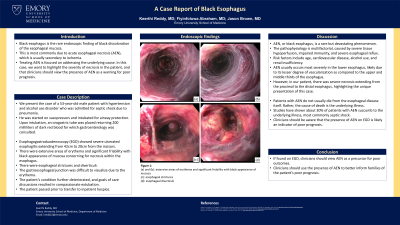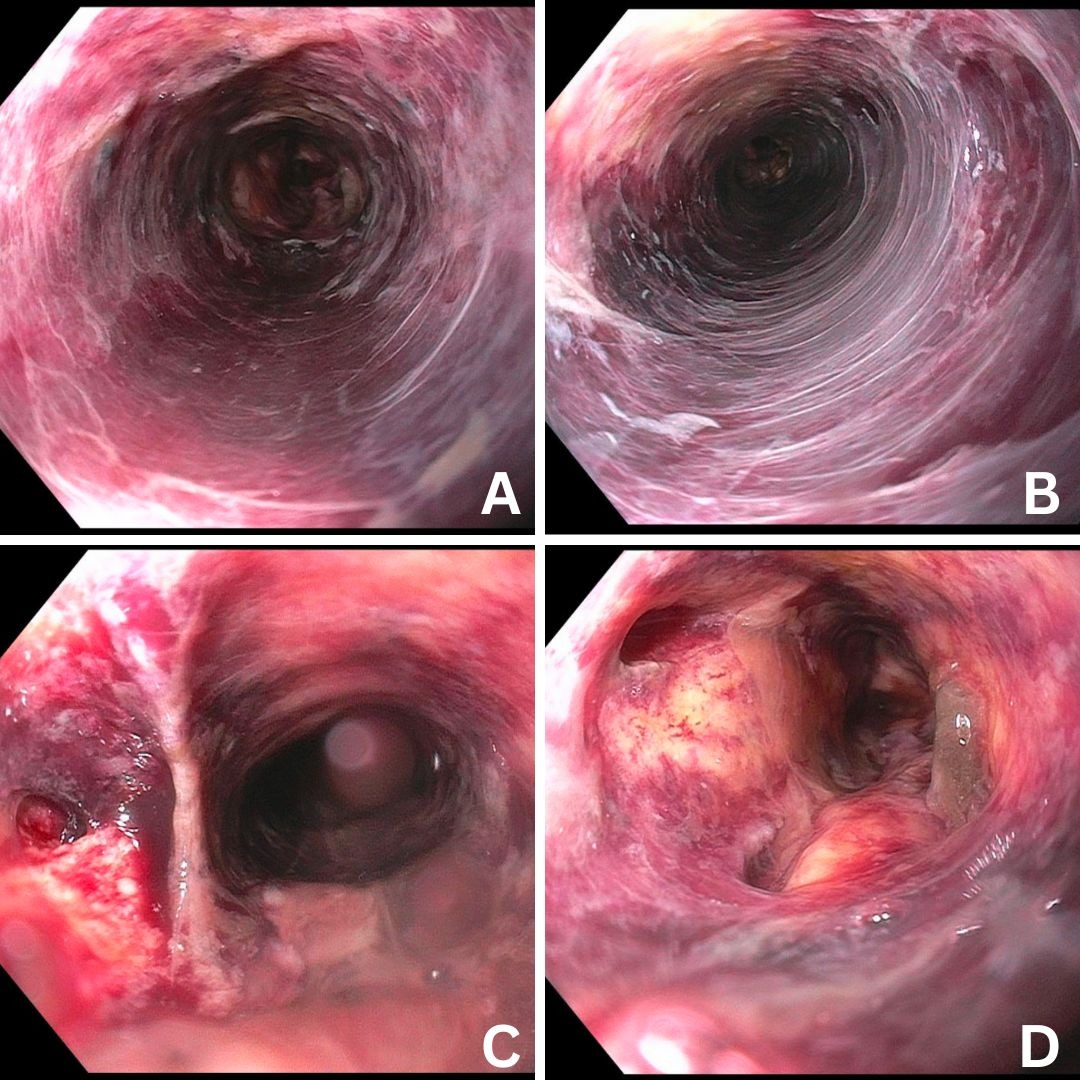Monday Poster Session
Category: Esophagus
P2275 - A Case Report of Black Esophagus
Monday, October 28, 2024
10:30 AM - 4:00 PM ET
Location: Exhibit Hall E

Has Audio
- KR
Keerthi Reddy, MD
Emory University School of Medicine
Atlanta, GA
Presenting Author(s)
Keerthi Reddy, MD, Fiyinfoluwa Abraham, MD, Jason Brown, MD
Emory University School of Medicine, Atlanta, GA
Introduction: Black esophagus is the rare endoscopic finding of black discoloration of the esophageal mucosa. This is most commonly due to acute esophageal necrosis (AEN), which is usually secondary to ischemia. Treating AEN is focused on addressing the underlying cause. In this case, we want to highlight the severity of necrosis in the patient, and that clinicians should view the presence of AEN as a warning for poor prognosis.
Case Description/Methods: We present the case of a 53-year-old male patient with hypertension and alcohol use disorder who was admitted for septic shock due to pneumonia. He was started on vasopressors and intubated for airway protection. Upon intubation, an orogastric tube was placed returning 200 milliliters of dark red blood for which gastroenterology was consulted.
Esophagogastroduodenoscopy (EGD) showed severe ulcerated esophagitis extending from 42cm to 20cm from the incisors. There were extensive areas of erythema and significant friability with black appearance of mucosa concerning for necrosis within the esophagus. There were esophageal strictures and diverticuli. The gastroesophageal junction was difficult to visualize due to the erythema. The patient’s condition further deteriorated, and goals of care discussions resulted in compassionate extubation. The patient passed prior to transfer to inpatient hospice.
Discussion: AEN, or black esophagus, is a rare but devastating phenomenon. The pathophysiology is multifactorial, caused by severe tissue hypoperfusion, impaired immunity, and severe esophageal reflux. Risk factors include age, cardiovascular disease, alcohol use, and renal insufficiency. AEN usually occurs most severely in the lower esophagus, likely due to its lesser degree of vascularization as compared to the upper and middle thirds of the esophagus. However, in our patient, there was severe necrosis extending from the proximal to the distal esophagus, highlighting the unique presentation of this case.
Patients with AEN do not usually die from the esophageal disease itself. Rather, the cause of death is the underlying illness. Studies have shown about 30% of patients with AEN succumb to the underlying illness, most commonly septic shock. If found on EGD, clinicians should view AEN as a precursor for poor outcomes. Clinicians should use the presence of AEN to better inform families of the patient’s poor prognosis.

Disclosures:
Keerthi Reddy, MD, Fiyinfoluwa Abraham, MD, Jason Brown, MD. P2275 - A Case Report of Black Esophagus, ACG 2024 Annual Scientific Meeting Abstracts. Philadelphia, PA: American College of Gastroenterology.
Emory University School of Medicine, Atlanta, GA
Introduction: Black esophagus is the rare endoscopic finding of black discoloration of the esophageal mucosa. This is most commonly due to acute esophageal necrosis (AEN), which is usually secondary to ischemia. Treating AEN is focused on addressing the underlying cause. In this case, we want to highlight the severity of necrosis in the patient, and that clinicians should view the presence of AEN as a warning for poor prognosis.
Case Description/Methods: We present the case of a 53-year-old male patient with hypertension and alcohol use disorder who was admitted for septic shock due to pneumonia. He was started on vasopressors and intubated for airway protection. Upon intubation, an orogastric tube was placed returning 200 milliliters of dark red blood for which gastroenterology was consulted.
Esophagogastroduodenoscopy (EGD) showed severe ulcerated esophagitis extending from 42cm to 20cm from the incisors. There were extensive areas of erythema and significant friability with black appearance of mucosa concerning for necrosis within the esophagus. There were esophageal strictures and diverticuli. The gastroesophageal junction was difficult to visualize due to the erythema. The patient’s condition further deteriorated, and goals of care discussions resulted in compassionate extubation. The patient passed prior to transfer to inpatient hospice.
Discussion: AEN, or black esophagus, is a rare but devastating phenomenon. The pathophysiology is multifactorial, caused by severe tissue hypoperfusion, impaired immunity, and severe esophageal reflux. Risk factors include age, cardiovascular disease, alcohol use, and renal insufficiency. AEN usually occurs most severely in the lower esophagus, likely due to its lesser degree of vascularization as compared to the upper and middle thirds of the esophagus. However, in our patient, there was severe necrosis extending from the proximal to the distal esophagus, highlighting the unique presentation of this case.
Patients with AEN do not usually die from the esophageal disease itself. Rather, the cause of death is the underlying illness. Studies have shown about 30% of patients with AEN succumb to the underlying illness, most commonly septic shock. If found on EGD, clinicians should view AEN as a precursor for poor outcomes. Clinicians should use the presence of AEN to better inform families of the patient’s poor prognosis.

Figure: A and B: extensive areas of erythema and significant friability of the esophagus with black appearance of mucosa
C: significant erythema of the esophagus and esophageal stricture
D: ulcerated ares of the esophagus and esophageal diverticuli
C: significant erythema of the esophagus and esophageal stricture
D: ulcerated ares of the esophagus and esophageal diverticuli
Disclosures:
Keerthi Reddy indicated no relevant financial relationships.
Fiyinfoluwa Abraham indicated no relevant financial relationships.
Jason Brown indicated no relevant financial relationships.
Keerthi Reddy, MD, Fiyinfoluwa Abraham, MD, Jason Brown, MD. P2275 - A Case Report of Black Esophagus, ACG 2024 Annual Scientific Meeting Abstracts. Philadelphia, PA: American College of Gastroenterology.
